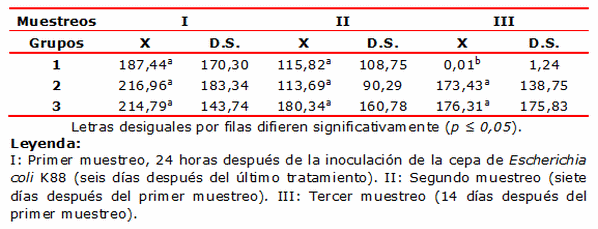Eficacia de un probiótico sobre Escherichia coli K88 en cerdos
El empleo de probióticos para mejorar la salud y la producción animal se ha motivado por los efectos beneficiosos de los mismos sobre el hospedero. Con el objetivo de evaluar la eficacia de un probiótico sobre la reducción de la carga bacteriana de Escherichia coli K88 en cerdos se aplicó un probiótico compuesto por Lactobacillusacidophilus y Streptococcustermophilus en cerdos de la categoría crías. Se conformaron tres grupos de cerdos; en todos los grupos el tratamiento se aplicó por vía oral, al momento del nacimiento y a las 24 horas siguientes. En el primer grupo se aplicó 5 mL del probiótico, que contenía miel de caña, levadura torula y cultivo de Lactobacillusacidophilusy Streptococcustermophilus; al segundo grupo se le aplicó 5 mL de miel de caña y levadura torula y al tercer grupo se le aplicó 5 mL de agua estéril. Todos los animales de los diferentes grupos se inocularon posteriormente por vía oral, con la cepa Escherichia coli K88. Se concluye que el empleo del probiótico reduce significativamente la carga bacteriana de la cepa Escherichia coli K88en heces fecales de cerdos a partir de los 14 días postratamiento.
Palabras clave: probióticos, Escherichia coli K88, cerdos.
ABSTRACT
The use of probiotics to improve health and animal production has been motivated by their beneficial effects on the host. In order to evaluate the efficacy of a probiotic on the reduction of the bacterial load of Escherichia coli K88 in swine, a probiotic, composed of Lactobacillus acidophilus and Streptococcus termophilus, was applied in breeding pigs. Three groups of pigs were formed. In all of them, the treatment was applied orally, at the time of birth and at the following 24 hours. In the first group, 5 mL of the probiotic, containing cane honey, torula yeast and cultureof Lactobacillus acidophilus and Streptococcus termophilus, were applied. The second group was applied 5 mL of cane honey and torula yeast, and the third group was applied 5 mL of sterile water. All the animals from the different groups were subsequently inoculated orally with the strain Escherichia coli K88. It is concluded that the use of this probiotic significantly reduces the bacterial load of the strain Escherichia coli K88
Key words: probiotics, Escherichia coli K88, swine.

1. Thacker PA. Alternatives to antibiotics as growth promoters for use in swine production: a review. J Anim Sci Biotech. 2013;4:35. doi:10.1186/2049-1891-4-35.
2. Crittenden R. Incorporating probiotics into foods. In Lee YK, Saminen S. Handbook of probiotics and prebiotics. 2009; 2.ed. Nova York: Wile-Interscience; p. 596.
3. Suo C, Yin Y, Wang X, Lou X, Song D, et al. Effects of Lactobacillus plantarum ZJ316 on pig growth and pork quality. BMC Vet Res. 2012;8:89. doi:10.1186/1746-6148-8-89.
4. Ohshima T, Kojima Y, seneviratne CJ, Maeda N. Therapeutic Application of symbiotic a Fusion of Probiotics and Prebiotics, and Biogenics as a New Concept for Oral Candida Infections: A Mini Review. Front Microbiol. 2016:(25)7:10.
6. De Almeida P, Teshima E, Ferreira C. Aspectos terapéuticos de probióticos, prebióticos e simbióticos. 2012; En: Prebióticos e Probióticos. Actualizacao e prospeccao. Capítulo 2, p.29. Editora Rubio. Brasil.
7. Roberfroid M, Gibson GR, Hoyles L, McCartney AL, Rastal R, Rowland I, Wolvers D B. Prebiotic effects: metabolic and health benefits. British Journal of Nutrition. 2010. 104 (Suppl.2):S1-S63.
8. Gupta V, Garg R. Probiotics. Indian J Med Microbiol. 2009;27(3):202-209.
9. Hemaiswarya S, Raja R, Ravikumar R, Carvalho IS. Mechanism of action of probiotics. Braz Arch Biol Technol. 2013;56(1):113-119.
10. Charteris, WP, Kelly PM, Morelli L, Collins JK. Development and application of an in vitro methodology to determine the transit tolerance of potencially probiotic Lactobacillus and Bifidobacterium species in the upper human gastrointestinal tract. J Appl Microbiol. 1998; 84:759-768.
11. Flaviano dos Santos M, Simone VG, Persichini RAC, Marcal SA, Neuman E, Moreira LJV, et al. Modelos Animais Gnotobióticos e convencionais para a selecao e avaliacao de probióticos. 2012; Libro: Prebióticos e Probióticos. Actualizacao e prospeccao. Capítulo 9, p. 145. Editora Rubio. Brasil.
12. Sekhon BS, Jairath S. Prebiotics, probiotics and symbiotics: An overview. J Pharmaceut Edu Res. 2010;1(2):13-36.
13. Yang F, Hou C, Zeng X, Qiao S. The use of lactic Acid bacteria as a probiotic in Swine diets. Pathogens. 2015;27;4(1):34-45.
14. Pérez Ruano M, Armenteros M, Vega E. Evaluación de la colonización del tracto digestivo de cerdos por cepas de Lactobacillus acidophilus y Streptococcus termophilus, componentes de un producto probiótico. Rev Salud Anim. 2014;36(3):141-146.
15. Krause DO, Bhandari SK, House JD, Nyachoti CM. Response of nursery pigs to a synbiotic preparation of starch and an anti-Escherichia coli K88 probiotic. Appl Environ Microbiol. 2010;76(24):8192-8200.
16. Hancox LR, Le Bon M, Richards PJ, Guillou D, Dodd, CER, Mellits, KH. Effect of a single dose of Saccharomyces cerevisiae var. boulardii on the occurrence of porcine neonatal diarrhoea. Animal. 2015;9(11):1756–1759.
17. Hermann-Bank ML, Skovgaard K, Stockmarr A, Strube ML, Larsen N, et al. Characterization of the bacterial gut microbiota of piglets suffering from new neonatal porcine diarrhoea. BMC Vet Res. 2015;11:139. doi: 10.1186/s12917-015-0419-4
18. Bhandari SK, Xu B, Nyachoti CM, Giesting DW, Krause DO. Evaluation of alternatives to antibiotics using an Escherichia coli K88 model of piglet diarrhea: effects on gut microbial ecology. J Anim Sci. 2008;86(4):836-847.
19. Casey PG, Gardiner GE, Casey G, Bradshaw B, Lawlor PG, Lynch PB, Leonard FC, Stanton C, Ross RP, Fitzgerald GF, Hill C. A five-strain probiotic combination reduces pathogen shedding and alleviates disease signs in pigs challenged with Salmonella enteric Serovar Typhimurium. Appl Environ Microbiol. 2007;73(6):1858-1863.
20. Guerra-Ordaz AA, González-Ortiz G, La Ragione RM, Woodward MJ, Collins JW, Pérez JF, Martín-Orúe SM. Lactose and Lactobacillus plantarum, a potential complementary synbiotic to control post weaning colibacillosis in piglets. Appl Environ Microbiol. 2014;80(16):4879-4886.
21. Zhang L, Xu YQ, Liu HY, Lai T, Ma JL, Wang JF, Zhu YH. Evaluation of Lactobacillus rhamnosus GG using an Escherichia coli K88 model of piglet diarrhoea: Effects on diarrhoea incidence, faecal microflora and immune responses. Vet Microbiol. 2010;141(1-2):142-148.
22. Qiao J, Wang Z, Li H, Wang W. Effects of Lactobacillus acidophilus dietary supplementation on the performance, intestinal barrier function, rectal microflora and serum immune function in weaned piglets challenged with Escherichia coli lipopolysaccharide. Antonie van Leeuwenhoek. 2015;107(4):883-891.
23. PajarilloE, Alain B., Jong P, Marilen P, Hyeun B.K, Chan-Soo P, DaeKyung K.. Effects of probiotic Enterococcus faecium NCIMB 11181 administration on swine fecal microbiota diversity and composition using barcoded pyrosequencing. Anim Feed Sci Tech. 2015;201:80-88.
24. Badia R, Zanello G, Chevaleyre C, Lizardo R, Meurens, F, et al. Effect of Saccharomyces cerevisiae var. Boulardii and b-galactomannan oligosaccharide on porcine intestinal epithelial and dendritic cells challenged in vitro with Escherichia coli F4 (K88). Vet Res. 2012;43:4. doi:10.1186/1297-9716-43-4.
25. Taras D, Vahjen W, Macha M, Simon O. Performance, diarrhea incidence, and occurrence of Escherichia coli virulence genes during long-term administration of a probiotic Enterococcus faecium strain to sows and piglets. J AnimSci. 2006;84(3):608-617.
26. Rodríguez JC, Carmenate MC, Hernández JE, Guerra A, Calero I, Álvarez JM, Martín E, Suárez M. Evaluación del suministro de un preparado biológico de Lactobacillus acidophillus y Streptococcus termophillus en cerdos en crecimiento. Rev Computadorizada de Producción Porcina. 2009;16(1):54-58.
27. Hou C, Zeng X, Yang F, Liu H, Qiao S. Study and use of the probiotic Lactobacillus reuteri in pigs: a review. J Anim Sci Biotechnol. 2015; 6(1):14.
28. Gardiner GE, Casey PG, Casey G, Lynch PB, Lawlor PG, Hil C, Fitzgerald GF, Stanton C, Ross P. Relative Ability of Orally Administered Lactobacillus murinusto Predominate and Persist in the Porcine Gastrointestinal Tract. Appl Environ Microbiol. 2004;70(4):1895-1906.
29. Robles-Huaynate RA, Thomaz MC, Santana AE, Hermans-Masson GCI, Borges AA, et al. Probiótico em dietas de suínos sobre os parâmetros sanguíneos e digestibilidade de rações. Semina: Ciências Agrárias, Londrina. 2014; 35(3):1627-1636.















